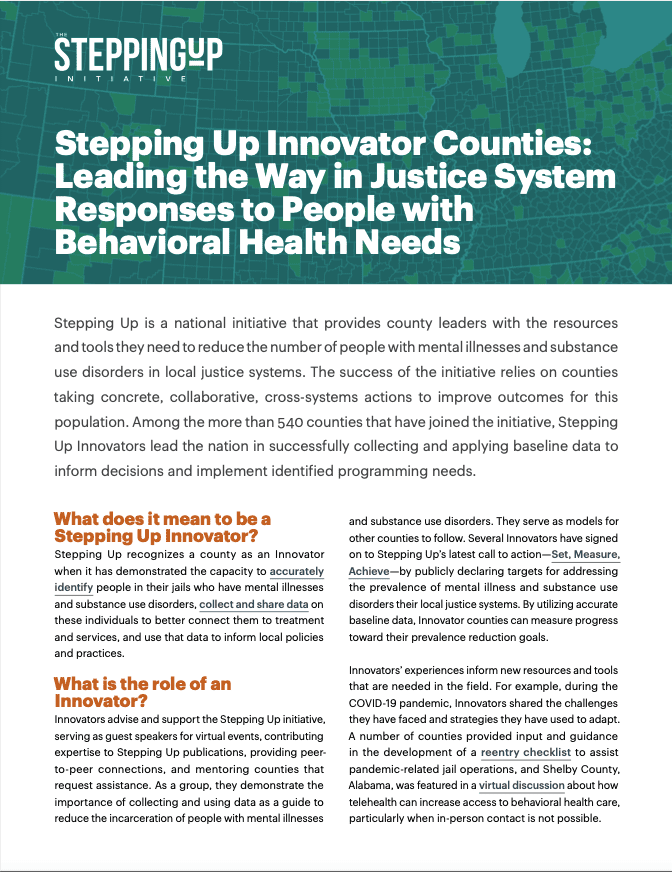Stepping Up Innovator Counties: Leading the Way in Justice System Responses to People with Behavioral Health Needs
Among the more than 540 counties that have joined the Stepping Up initiative, Innovator counties lead the nation in successfully collecting and applying data to inform decision-making. This brief covers how Innovators are bringing about meaningful change in the movement to reduce the number of people with behavioral health needs in local jails.
Stepping Up Innovator Counties: Leading the Way in Justice System Responses to People with Behavioral Health Needs
Stepping Up is a national initiative that provides county leaders with the resources and tools they need to reduce the number of people with mental illnesses and substance use disorders in local justice systems. The success of the initiative relies on counties taking concrete, collaborative, cross-systems actions to improve outcomes for this population. Among the more than 540 counties that have joined the initiative, Stepping Up Innovators lead the nation in successfully collecting and applying baseline data to inform decisions and implement identified programming needs.
What does it mean to be a Stepping Up Innovator?
Stepping Up recognizes a county as an Innovator when it has demonstrated the capacity to accurately identify people in their jails who have mental illnesses and substance use disorders, collect and share data on these individuals to better connect them to treatment and services, and use that data to inform local policies and practices.
What is the role of an Innovator?
Innovators advise and support the Stepping Up initiative, serving as guest speakers for virtual events, contributing expertise to Stepping Up publications, providing peer-to-peer connections, and mentoring counties that request assistance. As a group, they demonstrate the importance of collecting and using data as a guide to reduce the incarceration of people with mental illnesses and substance use disorders. They serve as models for other counties to follow. Several Innovators have signed on to Stepping Up’s latest call to action—Set, Measure, Achieve—by publicly declaring targets for addressing the prevalence of mental illness and substance use disorders in their local justice systems. By utilizing accurate baseline data, Innovator counties can measure progress toward their prevalence reduction goals.
Innovators’ experiences inform new resources and tools that are needed in the field. For example, during the COVID-19 pandemic, Innovators shared the challenges they have faced and strategies they have used to adapt. A number of counties provided input and guidance in the development of a reentry checklist to assist pandemic-related jail operations, and Shelby County, Alabama, was featured in a virtual discussion about how telehealth can increase access to behavioral health care, particularly when in-person contact is not possible.
How do Innovators use data to bring about meaningful change?
Equipped with accurate and accessible data on the prevalence of mental illness and substance use disorders in their local jails, Stepping Up Innovator counties can effectively match people to appropriate services and supports that help address their needs and reduce their likelihood of reoffending. Innovators are also able to use data to pinpoint where to implement an array of systems-level, community-based responses that ultimately reduce avoidable contact with the justice system in the first place. Frequently, these responses focus on diversion efforts.
Early interventions
Many Innovators are focusing on responses at the very front end of the justice system—or even before justice system contact—to ensure that people with mental illnesses and substance use disorders are connected to treatment rather than arrested, as appropriate.
San Luis Obispo County, California, implemented a countywide, cross-systems Crisis Intervention Team program to divert individuals with mental illnesses from jail.
Philadelphia County, Pennsylvania, embedded a full-time clinician at its 911 call center, with plans to scale up for 24/7 coverage.
Bernalillo County, New Mexico, implemented a peer response team for people in crisis.
Fulton County, Georgia, created a community responder team that is dispatched via 311.
Co-responder models
Co-responder models, where health care professionals answer calls for service along with law enforcement, are gaining momentum across the country. Innovator counties are implementing these models, but most indicate that they are striving to increase service capacity to meet the needs of the community.
Dauphin County, Pennsylvania; Johnson County, Kansas; Marion County, Indiana; and Bernalillo County all have scaled up co-responder programs.
Johnson County’s co-response efforts have grown from having one co-responder in one jurisdiction to having a mental health professional in 11 of its local police departments and within the sheriff’s office, providing countywide coverage for at least one shift.
Philadelphia County plans to increase its co-response model to include follow-up services.
Meanwhile, Cumberland County, Pennsylvania; Mobile County, Alabama; and Reno County, Kansas, are in the early stages of developing co-responder services.
Crisis and diversion centers
Several counties have established crisis stabilization units (CSUs) or some form of a diversion drop-off center where individuals are screened and referred to appropriate services and supports.
Bernalillo County’s Behavioral Health Campus offers a full spectrum of services, including an intervention program for people with substance use disorders, crisis observation beds, and longer-term/residential care.
Douglas County, Kansas, is in the process of opening a similar campus that will include three tiers of supportive housing, taking in individuals experiencing a behavioral health crisis and helping them recover to the point where they can live in permanent housing.
In December 2020, Marion County opened its state-of-the-art Assessment Intervention Center in Indianapolis. Since then, the center has implemented a validated screening tool for law enforcement officers to use at the scene to determine a person’s appropriateness for diversion.
Fairfax County, Virginia, operates a 24/7 center where law enforcement officers transport people experiencing behavioral health crises for services and supports in lieu of arrest or jail.
Johnson County’s CSU is shared with a neighboring county and includes substance use treatment and services.
Dallas County, Iowa, operates a crisis center that also serves as a law enforcement drop-off site with substance use treatment services and a transitional living program for people diverted from jail.
Franklin County, Ohio, and Mobile County are in the process of building one-stop crisis centers to divert mental health crisis calls to treatment.
Other Innovators, such as Polk County, Iowa, are developing an in-home crisis care model to offer an additional option for people experiencing a crisis.
Identifying and serving high-needs populations
Many Innovator counties are either identifying people who frequently encounter police, jail, and emergency services or developing criteria to do so. These criteria vary from county to county and are often dependent on which systems will share data with each other.
Fairfax County defines these individuals as community members who cycle through public safety, behavioral health treatment, and emergency room services and have accessed public safety services at least 6 times in 60 days. To help serve these high-needs individuals, Fairfax County’s Community Response Team provides outreach, care coordination, and linkages to needed services.
Bernalillo, Fulton, Polk, and Marion Counties all have efforts underway to establish services for individuals who frequently cycle through these systems.
Douglas and Sarpy Counties in Nebraska offer intensive case management services to these community members, and Mobile County has implemented a Forensic Assertive Community Treatment team.
Cumberland County opened an eight-bed Long Term Structured Residence program in September 2020 to serve individuals with serious mental illnesses and offer supportive services, while Dauphin County opened a Forensic Community Residential Rehabilitation program in January 2021.
Many Innovators embed clinicians inside their jail to address treatment needs and provide post-release outreach to ensure connection to care. Marion County is developing a High Utilizer of Multiple Systems initiative that brings together criminal justice, homelessness, and behavioral health data to identify individuals who need intervention as well as inform program and policy reform.
Johnson County developed a predictive model used at jail booking to identify individuals at risk of rearrest and provide outreach services for them. Additionally, a recent Notre Dame University study of Johnson County found that rebookings into jail decreased significantly when ongoing treatment was established as needed after release.
How can my county become an Innovator?
The Stepping Up partners identify and cultivate potential Innovator counties on an ongoing basis. Learn more at stepuptogether.org/innovator-counties and fill out this short questionnaire if you think your county meets the Innovator criteria.
To be connected with an Innovator county, find out more about their efforts, and discuss successes and challenges, email info@stepuptogether.org.
Stepping Up is a national initiative to reduce the number of people with mental illnesses in jails and is the result of a partnership between The Council of State Governments Justice Center, the National Association of Counties, and the American Psychiatric Association Foundation. This project was supported by Grant No. 2019-MO-BX-K002 awarded by the Bureau of Justice Assistance. The Bureau of Justice Assistance is a component of the Department of Justice’s Office of Justice Programs, which also includes the Bureau of Justice Statistics, the National Institute of Justice, the Office of Juvenile Justice and Delinquency Prevention, the Office for Victims of Crime, and the SMART Office. Points of view or opinions in this document are those of the author and do not necessarily represent the official position or policies of the U.S. Department of Justice.
Project Credits
Writing: Risë Haneberg, CSG Justice Center
Research: Risë Haneberg, CSG Justice Center
Advising: Kati Habert and Mark Stovell, CSG Justice Center
Editing: Katy Albis and Emily Morgan, CSG Justice Center
Design: Michael Bierman
Public Affairs: Ruvi Lopez and Andrew Currier, CSG Justice Center
About the Author
The sharp rise in school shootings over the past 25 years has led school officials across the U.S.…
Read MoreA three-digit crisis line, 988, launched two years ago to supplement—not necessarily replace—911. Calling 988 simplifies access to…
Read More Taking the HEAT Out of Campus Crises: A Proactive Approach to College Safety
Taking the HEAT Out of Campus Crises: A Proactive Approach to College Safety
The sharp rise in school shootings over the past 25 years has…
Read More From 911 to 988: Salt Lake City’s Innovative Dispatch Diversion Program Gives More Crisis Options
From 911 to 988: Salt Lake City’s Innovative Dispatch Diversion Program Gives More Crisis Options
A three-digit crisis line, 988, launched two years ago to supplement—not necessarily…
Read More Matching Care to Need: 5 Facts on How to Improve Behavioral Health Crisis Response
Matching Care to Need: 5 Facts on How to Improve Behavioral Health Crisis Response
It would hardly be controversial to expect an ambulance to arrive if…
Read More














